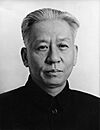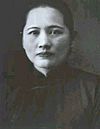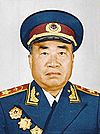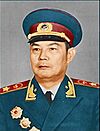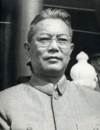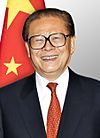List of state representatives of the People's Republic of China facts for kids
All the names on this list follow the Eastern order convention (family name first, personal name second).
The president of the People's Republic of China is a very important leader in China. This position was first created in 1954 when China set up its first official government system. Back then, the title was called State Chairman. The job of president was removed between 1975 and 1982. During that time, the leader of the Standing Committee of the National People's Congress acted as the country's main representative. The role of president was brought back in 1982.
Contents
China's Top Leaders Over Time
- Generations of leadership
- Mao Zedong's Time
- Deng Xiaoping's Time
- Jiang Zemin's Time
- Hu–Wen Administration
- Xi–Li Administration/Xi Jinping Administration
Early Leaders (1949–1954)
- Chairman of the Central People's Government
| Picture | Name (Years Lived) |
Time in Office | Other Important Leaders | Main Leader | |||
|---|---|---|---|---|---|---|---|
| – | Mao Zedong 毛泽东 (1893–1976) |
1 October 1949 | 27 September 1954 | Zhu De Liu Shaoqi Soong Ching-ling Li Jishen Zhang Lan Gao Gang |
Himself | ||
| Mao Zedong was also the leader of the Chinese Communist Party and the military. This made him the most powerful person in China. | |||||||
First Presidents (1954–1975)
- Chairman of the People's Republic of China
| No. | Picture | Name (Years Lived) |
Time in Office | NPC | Vice Presidents | Main Leader | |
|---|---|---|---|---|---|---|---|
| 1 | Mao Zedong 毛泽东 (1893–1976) |
27 September 1954 | 27 April 1959 | I | Zhu De | Mao Zedong | |
| 2 | Liu Shaoqi 刘少奇 (1898–1969) |
27 April 1959 | 3 January 1965 | II | Soong Ching-ling Dong Biwu |
||
| 3 January 1965 | 31 October 1968 | III | |||||
| acting | Soong Ching-ling 宋庆龄 (1893–1981) |
31 October 1968 | 24 February 1972 | III | Dong Biwu | ||
| acting | Dong Biwu 董必武 (1886–1975) |
24 February 1972 | 17 January 1975 | III | Soong Ching-ling | ||
When the Presidency Was Abolished (1975–1982)
- Chairman of the Standing Committee of the National People's Congress
| Picture | Name (Years Lived) |
Time in Office | NPC | Other Leaders | Main Leader | |||
|---|---|---|---|---|---|---|---|---|
| – | Zhu De 朱德 (1886–1976) |
17 January 1975 | 6 July 1976 | IV | Soong Ching-ling Dong Biwu (died 2 April 1975) and others |
Mao Zedong | ||
| – | Soong Ching-ling 宋庆龄 (1893–1981) |
6 July 1976 | 5 March 1978 | Mao Zedong Hua Guofeng |
||||
| After Zhu De passed away, Soong Ching-ling took on the role of acting Chairwoman. She was a member of a different political group called the Revolutionary Committee of the Kuomintang. | ||||||||
| – | Ye Jianying 叶剑英 (1897–1986) |
5 March 1978 | 18 June 1983 | V | Soong Ching-ling and others |
Hua Guofeng Deng Xiaoping |
||
- Honorary Chairwoman of the People's Republic of China
| Picture | Name (Years Lived) |
Time in Office | NPC | Notes | ||
|---|---|---|---|---|---|---|
| – | Soong Ching-ling 宋庆龄 (1893–1981) |
16 May 1981 | 29 May 1981 | V | Just before she passed away, Soong Ching-ling was given the special title of Honorary Chairwoman of China. | |
The Presidency Returns (1983–Present)
- President of the People's Republic of China
| Picture | Name (Years Lived) |
Time in Office | NPC | Vice President | Main Leader | ||
|---|---|---|---|---|---|---|---|
| 3 | Li Xiannian 李先念 (1909–1992) |
18 June 1983 | 8 April 1988 | VI | Ulanhu | Deng Xiaoping | |
| During Li Xiannian's time, China started to open up more to other countries. He was the first Chinese President to visit the United States and North Korea. He met with U.S. President Ronald Reagan in 1984. | |||||||
| 4 | Yang Shangkun 杨尚昆 (1907–1998) |
8 April 1988 | 27 March 1993 | VII | Wang Zhen | Deng Xiaoping Jiang Zemin |
|
| Yang Shangkun was a leader who had been through many changes in China's history. He supported economic changes but was against too much political freedom. He retired after facing disagreements with Jiang Zemin's leadership. | |||||||
| 5 | Jiang Zemin 江泽民 (1926–2022) |
27 March 1993 | 15 March 1998 | VIII | Rong Yiren | Himself | |
| 15 March 1998 | 15 March 2003 | IX | Hu Jintao | ||||
| Jiang Zemin became President in 1993. He also held other powerful roles, making him a very strong leader. Under his leadership, China grew a lot economically. He oversaw the return of Hong Kong from the United Kingdom and Macau from Portugal to China. He also improved China's relationships with other countries. | |||||||
| 6 | Hu Jintao 胡锦涛 (born 1942) |
15 March 2003 | 15 March 2008 | X | Zeng Qinghong | Himself | |
| 15 March 2008 | 14 March 2013 | XI | Xi Jinping | ||||
| Hu Jintao became President in 2003. He also led the Communist Party and the military. During his time, China's economy grew steadily, and the country became a major world power. | |||||||
| 7 | Xi Jinping 习近平 (born 1953) |
14 March 2013 | 17 March 2018 | XII | Li Yuanchao | Himself | |
| 17 March 2018 | 10 March 2023 | XIII | Wang Qishan | ||||
| 10 March 2023 | Incumbent | XIV | Han Zheng | ||||
| Xi Jinping became President in 2013. He also leads the Communist Party and the military. He has made the president's role more visible in international affairs, meeting with many world leaders. Under his leadership, China has focused on fighting corruption. In 2018, the rules about how long a president can serve were changed, removing term limits. | |||||||
Timeline of Leaders
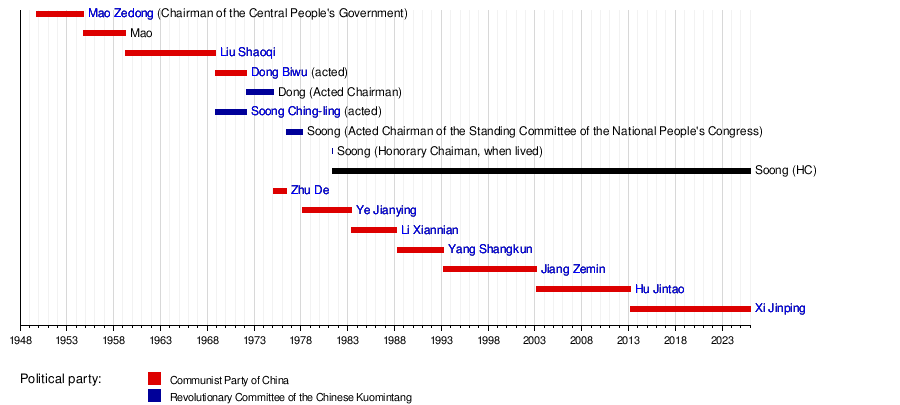
See also
- List of Chinese leaders
- Leader of the Chinese Communist Party
- Order of precedence in China
- Paramount leader - a informal list of those who have been considered the highest leader of the party and the People's Republic of China

All content from Kiddle encyclopedia articles (including the article images and facts) can be freely used under Attribution-ShareAlike license, unless stated otherwise. Cite this article:
List of state representatives of the People's Republic of China Facts for Kids. Kiddle Encyclopedia.


